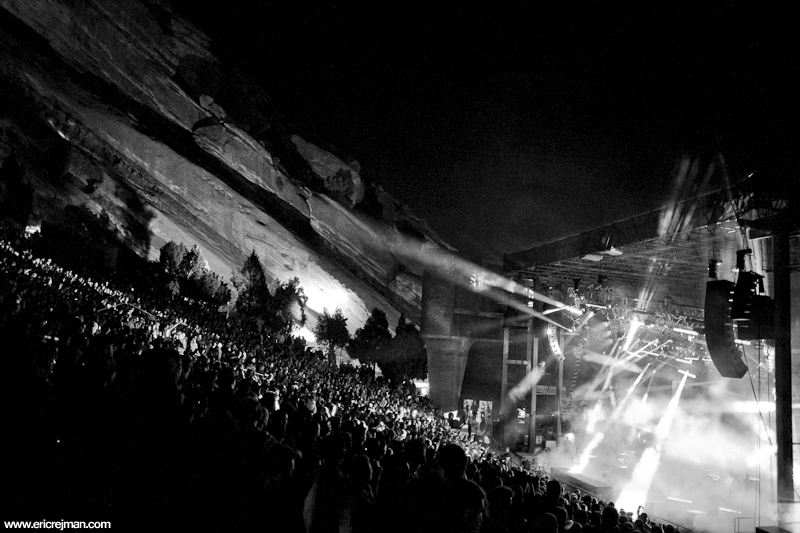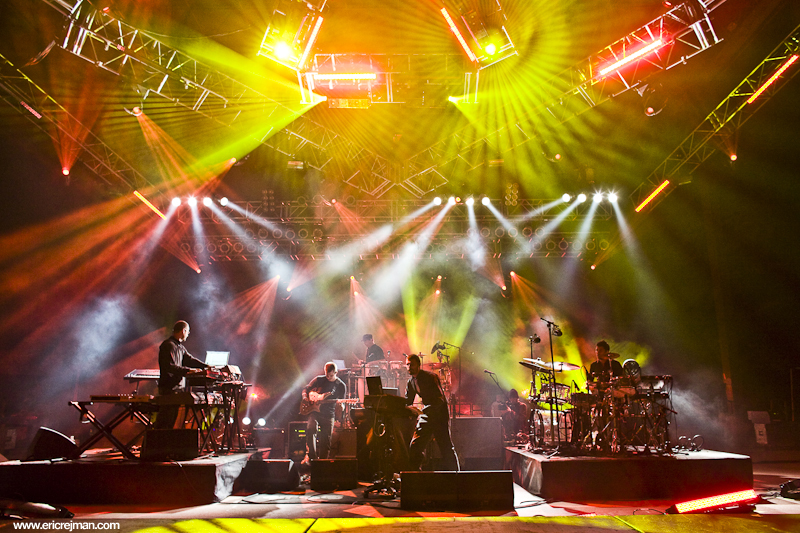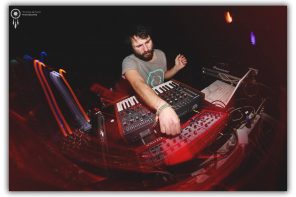Some of the most influential bands of the decade are known for their live improvisation and massive touring schedules. When these bands release studio albums they are often listened to less frequently than live soundboards, and are usually not big sellers. But they do exist as milestones. These albums are met with a mixture of reviews from those fans who have caught the group’s live shows at venues and festivals across the country, anticipating what lies next on the band’s-and their own-horizon.
I think that all of our community’s favorite bands-the ones that have been bringing the heat for the better half of a decade-are experiencing a period of obvious change. The expanding and volatile nature of their fanbases and of modern music production has made it possible-almost necessary-for bands like Sound Tribe Sector 9, The Disco Biscuits, and The New Deal to update and recondition their sound. Studio work, though often criticized for its processed nature, exists today as a turning point for these bands.
After the release of STS9’s 2008 studio work, “Peaceblaster”, things changed. The band’s live show was effected, as they proceeded to implement the new tracks as predominant choices in their set lists. Aged Tribe followers and new fans alike, both experienced shows this past year which leaned towards that “Peaceblaster” sound-a heavy flood of electronic experimentation. Personally, I felt like the live result was that of system overload. Murph’s hands could be seen on his computer more than his bass, Zach’s drumming seemed like it was straining to be heard over the multiple powerhouse electronic sounds.
I admit that this new sound has produced massive dance parties, with fans constantly moving and grooving to a number of synthetic beats. However, I don’t think that STS9 accomplished the highest quality of song composition they are capable of accomplishing with “Peaceblaster.” This became clear to me in Jason Turgeon’s Jambase article published this June, as keyboardist David Phipps said: “We’ve gone… I don’t want to say as far we can, but we’ve really gone headfirst into that whole methodology of creating music and being able to bring something that’s bigger than your own instrument to the stage and pull it off – the laptop AND the guitar. But now the pendulum’s swinging [and] we find ourselves playing acoustic guitar and a real piano and trying to write some really beautiful progressions and melodies that are just really strong [and] timeless. The next round of Sector 9 might be completely different.”
Now, with the band’s first ever entirely acoustic set, “Axe the Cables,” scheduled for December 29th at the Newman Center opera house in Denver, and the release of Sound Tribe Sector 9’s newest studio album, “Ad Explorata”-that round is upon us.
AD EXPLORATA
“Ad Explorata, due out November of 2009, inspired by the idea that there is always more to be discovered, manifested by the belief that you can always push towards the unknown and unexplored, and created by the will and desire for constant artistic evolution, expression and change.” –STS9.com/adexplorata
You can stream the entire album and read up on the strange origins of the album HERE (www.sts9.com/adexplorata)
You can buy the MP3 or Flac version of the new album HERE
“Phonome”-
This one starts out like a prolonged magical event in some fairy tale, smooth and blinking. Tribe uses a few sounds on top of the minimal piano progression here that seem related to the short wave radio that they mention in the album’s info. The guitar strums in at 2:30, reverberating with every pull of the strings. A fat, but sleek bass line drops in. The layers revolve around each other, then Zach Velmer’s drums top the mesh of instruments off. First, with organic beats that hold it all together and then with electronic drum beats that he eases into. The complex middle section of the song fades off, as the minimal and beautiful sounds are left to round this one off.
“Heavy”-
It starts off as the name suggests, “Heavy.” Begins with drums that sound like an army of warriors are preparing themselves for some epic battle. The synth brings in string sounds that work to fortify the epic sound. All the while, a fast paced bleeping sound seems to never end, until it is replaced by a harp-like guitar riff which lulls the song in one direction while the percussion keeps the pace up for the heavy progression from the beginning to return to the forefront. Towards the end of this track, I can tell that this album holds onto that same Sound Tribe mentality of major electronic jams, but that the method is somewhat different than in the past. The electronic elements seem to coincide more cohesively with the organic elements. You will obviously still need to be wearing your robot ears for this album, but it has a greater element of composition-which I think new listeners can come to dig.
“Looking Back on Earth”-
The first few times I heard this song sitting in the library sober, I had to play it over and over to make sure it was Tribe. But the first time I listen to it stoned, I noticed the typical Tribe breaks within the dizzying, mind-mixing progressions. Soothing synth and strings start it off, as they create a sound as if the steam is being let out-but with a more organic feel to it than when Trentmoller does it. The crisp and necessary sound of the percussion section can be heard on this track, despite all the fresh ear catching sounds that seem to appear every 30 seconds (empty pops, random bleeps). Each instrument builds up a new sound, and trades it off to another instrument to provide the same effect. At one point, I realize that I’m not even in the mood to dance. I know there is more to music than simply moving around to it out of physical habit, with some songs there is an experience to be had. Personally, I think this is what I had the most problem with Tribe’s material this past year, not enough to take in, too much to simply “get down to”. Soft, nominal piano parts fade in and out of what sounds like a curtain of sound. By the end it sounds as if the band is simply turning each different sound up and down-which provides a nice finish.
“Oil and Water”-
The third and final single release before the album drop. It really got me excited about the album for the first time, and turns out to be my favorite song on the album. Tribe is back to old form with this new track, bringing us some fresh and ill robotic future space sounds. Close your eyes on this one, and all kinds of futuristic wonders can ensue as you visualize a scene that matches the music. My roommate Rob Uslan described it as seeing the inside of a machine’s guts. This song really forces you to develop an experience by listening. Tribe breaks their habit here, by creating something that exists as more than just a banging dance track. It’s minimal like much of this album, but far from bare, as there is so much to listen for. In my opinion, in order for the band to reach their highest potential everyone in the band needs to operate at 100%-producing five separate, ill parts multiple times on every track.
“Crypto City”-
The shortest track on the album, short and sweet. A synthesis of electronic tones. Beat after beat surfaces, one after another, trading off into a spiraling conglomeration. When this song begins it sounds like the warp engine of the Millenium Falcon is trying to start up, but fails to reach full speed. Another slow, simple piano progression enters. The result is a slow moving sound that makes me feel like I’m watching a heap of circuit-like molasses sliding downward slowly, mechanically. It fades out, holding on by a low repeating sound and builds back up by way of a pretty piano/synth progression.
“EHM”-
“EHM”, one of my favorite songs live. The first part of the song is subtle and airy, and the second half shows just how hard Tribe beats can get. The “Ad Explorata” version is clean, with a few minor changes and new parts. This version is more about the details. When the familiar, heavy bass drops there is more to it. It’s more than just the overwhelming bass drop that it can sometimes be live. You can really hear the extra levels layered on top of it simultaneously. The result is a warm fuzzy feeling. There is a moment five minutes in, when the different instruments merge to form a hard hitting, ankle kicker of a jam where the bass, the synth, the laptop, and the drums are all prominent and compelling. To end the track, the song slows and quiets down in a more well composed, relaxed way than the live version. Finally, the boys do one of their best jams justice in the studio.
“Atlas”-
This was our first glimpse of “Ad Explorata”, as Tribe released “Atlas” as the first single off the album months ago. One of the tracks on the album that has been played a number of times this year during live STS9 shows. I remember hearing it played at Wakarusa on the Main Stage, and it definitely had more of a detached, jam quality to it. Murph, David, and Hunter all worked off their computers and the result was really a condensed version of the song. I was more intrigued by the studio version of the song, as it sounds as though the band layed off the computer. Murph lays down a pretty nasty bassline throughout the song, strange eerie almost-autotuned voices can be heard, but I’m really not a fan of the loud, obnoxious and screechy central synth sound that enters at 1:46. All in all, “Atlas” isn’t one of my favorite songs, and definitely the weakest track on the album.
“Ad Explorata”-
“It was thought to be for a secret unit that first used satellites to gather SIGINT (signal intelligence) from other countries during the Cold War. The story is that this team actually gathered signals from another civilization in our galaxy. Their motto was ‘Ad Explorata, Forward into the Unexplored.”- STS9.com/adexplorata
Low tones, fleeting high-hat/snare drum beats, some really beautiful horns, and weird distorted electro sounds that remind me of circuit bending. These all just trade off, pulsing slow. I almost (actually) start to sway my hips and shoulders to the beat, thinking it would be a good one for under the sheets. Despite the beautiful result of the minimal work here, I wish this track was a little longer and had more to it.
“Re:Stereo”-
Once again, this song starts with some piano and guitar progressions that really leave me asking the question, “Is this STS9?“. Hunter Brown demonstrates his incredible versatility here. One for the Acoustic Set I’m sure, as the song is made up of warm, organic parts. Halfway through, the bass and snare enter softly-slowly building the track to a slightly quicker pace. This build is done gradually, without force. The beautiful piano and guitar progressions mesh perfectly with the smooth beat. Things quiet down again, as short notes are played Jeffree Lerner by xylophone and chimes. This track is really a wonder. I hear an album Sigur Ros sound on this track. Tribe attempts to create something serene, something unlike much of what you expect from them-and they succeed. I recommend listening to “Re:Stereo” lying still in bed.
“Lion”-
Another new song played at Tribe’s 2009 shows, including their October 22nd show at the House of Blues in Boston. Begins with some windy percussion sounds-chimes, maracas, and what sounds like a rain stick. At 0:37, multiple deep organic and synthetic bass sounds enter and work with Lerner’s heavy hitting hand percussion. The strange windy, airy sounds appear again half-way through the song, giving the bass a break for a bit. The song definitely has peaks and valleys, as it pulls away from and back towards the seriously heavy overall tone.
“Central”-
“Keyboardist David Phipps’ daughter Aya was playing around with the dials when all of a sudden it stopped on this voice on the super low frequencies of the spectrum. It was a woman’s voice, artificial we later found out, counting off numbers in a very clear and concise way. We became obsessed with what we had heard and for weeks we sat behind the dials trying to find more voices.
There was only one more to be found, the voice we sampled for the beginning of the song “Central”. After a bit of research, we found that these were numbers stations, thought to be coded messages various governments use to send correspondence to spy’s overseas. ” – STS9.com/Adexplorata
“Ready. Ready. 3.5.2.1.7.9.3.2.(Scratchy Shortwave Radio Audio)”. It starts with the strange, coded transmission that Tribe focused on as they produced this album. The woman’s voice repeats numbers, repeated in a complex sequence. The music drops with the synth and minimal percussion played on top of the numbers. A deep bass line comes in alone and keeps a slow, hypnotizing beat. David Phipps and Lerner drop the computer sounds, each circling around the bass. The voice resurfaces, and the song proceeds to sound like some strange conversation-with each part speaking in a totally separate language, meant to mystify and perplex the listener.
“Echoes”-
With STS9 bassist, David Murphy, playing in the Pink Floyd cover group, “Pigs on the Wing”, this year; perhaps the title is a reference to the Pink Floyd song? It begins with very low, drawn out sounds-much like Floyd was known for. Acoustic guitar riffs really make this song. Two riffs mesh wonderfully together, as the electronic department of the group experiments with some almost ghostly, wispy noises that take the second half of this song over. Although there isn’t much to this track-as far as sheer notes and measures-it really leaves an impression on me. I can sense a difference in the scope of STS9’s sound, and I think that is why they chose this song to finish things off.







